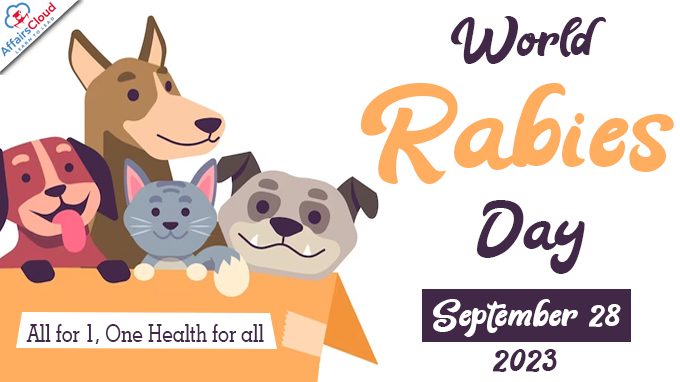 World Rabies Day (WRD) is annually observed across the globe on 28 September to raise awareness of rabies prevention and to highlight progress in defeating this horrifying disease. The day also aims to advocate for rabies elimination globally.
World Rabies Day (WRD) is annually observed across the globe on 28 September to raise awareness of rabies prevention and to highlight progress in defeating this horrifying disease. The day also aims to advocate for rabies elimination globally.
- 28th September 2023 marks the 17th observance of WRD.
The theme of WRD 2023 is “Rabies: All for 1, One Health for All”.
- The theme adds the additional layer of highlighting the need for collaboration, the importance of equality, and strengthening overall health systems by ensuring that One Health is not for a selected few but for everyone.
Background:
i.In 2007, World Rabies Day was established by the Global Alliance for Rabies Control (GARC), a non-profit organization aimed to eliminate human deaths from dog rabies by 2030, and later endorsed by the World Health Organization (WHO).
- It is an event designed to be inclusive, uniting people, organizations, and stakeholders across all sectors against rabies.
ii.The first WRD was observed on 28 September 2007.
Why September 28?
The date 28 September was chosen as it commemorates the death anniversary of Louis Pasteur (28 September 1895), the French chemist and microbiologist.
- He developed the first rabies vaccine and laid the foundation for the manufacture of many other vaccines.
About Rabies:
i.Rabies is a zoonotic disease (transmitted between animals and humans) caused by rabies virus (RABV), a Ribonucleic Acid (RNA) virus.
- Taxonomically, RABV belongs to the genus Lyssavirus, family Rhabdoviridae.
ii.It is the deadliest disease on earth with a 99.9% fatality rate. It causes progressive and fatal inflammation of the brain and spinal cord.
About Rabies Vaccine:
i.Rabies vaccine is an active immunizing agent used to prevent infection caused by the rabies virus.
ii.Louis Pasteur developed the earliest effective vaccine against rabies, first used to treat a human bite victim.
iii.On July 6, 1885, Louis Pasteur administered his first experimental rabies vaccine to a 9-year-old human patient, Joseph Meister.
iv.WHO recommends 2 main immunization strategies for the prevention of human rabies namely Post-exposure prophylaxis (PEP) and Pre-exposure prophylaxis (PrEP).
Key Facts:
i.Rabies is a 100% vaccine-preventable viral disease in more than 150 countries and territories.
ii.It causes tens of thousands of deaths every year, mainly in Asia and Africa, 40% of whom are children under 15 years of age.
iii.Dogs are the main source of human rabies deaths, contributing up to 99% of all rabies transmissions to humans. Rabies can be prevented through vaccination of dogs and the prevention of dog bites.
- Globally rabies causes an estimated cost of USD 8.6 billion per year.
iv.Rabies is present on all continents except Antarctica, with over 95% of human deaths occurring in Asia and Africa.
v.Vaccination of at least 70% of dogs in areas at risk is now accepted as the most effective way of preventing human rabies deaths.
Collaboration of International organizations for eliminating Rabies:
The major organizations working together to eliminate rabies deaths in people that are caused by dogs by 2030 are:
- WHO; the World Organisation for Animal Health (OIE), the World Organisation for Animal Health (WOAH), the United Nations the Food and Agriculture Organization (FAO), GARC, Centers for Disease Control and Prevention, the United States Department of Agriculture (USDA).




